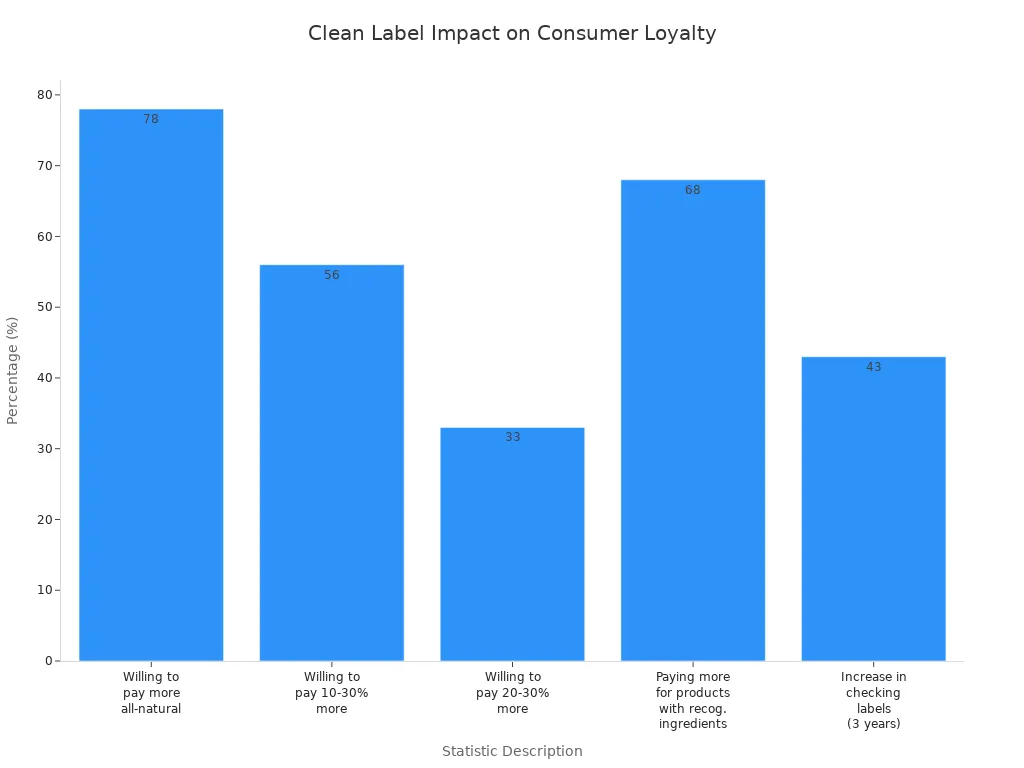
作者:Cuiguai风味研发团队|日期:2025年8月24日

丰富的早餐交响曲:从水果到烘焙食品的味蕾的盛宴
优质食品口味通过提供出色的口味体验来激发产品创新并促进消费者的忠诚度。味道一直是食品和饮料决策中最强大的购买动力:
高质量的成分和专家风味配方有助于品牌建立信任,建立情感联系并在拥挤的市场中脱颖而出。

香料谱:视觉中的美味调味料
高级食品口味通过提供出色的口味和令人难忘的体验,在拥挤的市场中与众不同。食品工业并未执行严格的法规,以将口味标记为高级或美食。品牌将这些术语用作营销策略来发出质量和排他性。消费者根据几个标准定义优质食品口味:
千禧一代和Z世代对高级食品口味表现出强烈的兴趣,寻求经验和健康益处。 COVID-19大流行加速了保费趋势,更多的消费者在国内寻求舒适和放纵。专注于质量而不是数量并提供手工,独特的风味体验的品牌获得了竞争优势。
笔记:有没有高级风味标签的官方监管标准。消费者的看法和品牌推动了高级领域,从而使建立信任至关重要。
独特的风味剖面在产品差异化中起着至关重要的作用。品牌创造根据区域偏好,饮食趋势和加工条件量身定制的自定义口味。这种方法允许产品直接吸引目标消费者。高质量和天然的风味成分可帮助制造商发展出持久印象的标志性口味。
消费者渴望两者他们选择的舒适和冒险.诸如香草豆和肉桂糖之类的怀旧口味提供了情感锚,而大胆的全球口味会兴奋和探索。品牌必须平衡熟悉的口味和创新的组合,以满足不断发展的消费者期望。
社交媒体会影响消费者尝试新的口味,年轻的人口统计数据导致人们对冒险和多维品味的需求。将近一半的千禧一代认为独特的口味使零食更加放纵,并且over 90% of Gen Z and Millennials actively seek novel taste experiences.
高级食品口味通过提高产品质量和品牌声誉而创造价值. High-quality ingredients lead to superior flavor, consistency, and health appeal. 消费者识别使用优质成分制成的产品,并将其与填充物的产品区分开。这种识别推动了重复购买并建立品牌信任。
注重健康的买家要求没有人工添加剂的天然,最少加工的食品。可持续的采购吸引了生态意识的消费者,进一步证明了高级定价。投资高质量的成分和透明标签是支持产品差异化和长期品牌增长的战略选择。
| 优质食品口味的标准 | 消费者影响 |
| 高质量的可持续成分 | 驱动重复购买和忠诚度 |
| 异国情调和全球风味曲线 | 吸引冒险的消费者 |
| 清洁标签和透明度 | 增加支付保费的意愿 |
| 手工生产方法 | 增强感知的价值和排他性 |
优质食品口味enable品牌创造的产品可以脱颖而出,在情感上引起共鸣并指挥更高的价格。通过专注于质量,创新和透明度,公司与消费者建立了持久的关系并确保其在市场上的地位。
风味创新推动了成功推出产品,并使品牌在快速变化的市场中相关。公司监视消费者的偏好并迅速适应新趋势。当今的消费者期望的不仅仅是良好的品味,而且想要与他们的生活方式和价值观相匹配的体验。
消费者也倾向于 nostalgic flavors like birthday cake and hot chocolate,在压力时期提供舒适感。冒险的口味探索种族融合,例如日本 - 意大利或英国印度混合物。诸如甜和辣(“旋转”),甜和烟熏(“宣誓”)以及独特的盐或辣椒等趋势组合增加了兴奋。健康和健康趋势继续塑造风味创新,重点是增强情绪和更健康的格式的放纵概况。
研发团队 collaborate with flavor partners to accelerate innovation.这些合作伙伴关系汇集了各种专业知识,共享资源和先进的技术。通过打破孤岛,团队解决了超越内部功能的复杂挑战。协作生态系统将成分供应商,产品开发人员和科学社会团结起来。这种方法可以加快创新过程,降低风险并提高生产率。
频繁的沟通和清晰的任务一致性确保每个人都朝着共同的目标努力。领导承诺和透明信息共享建立信任和弹性。访问更广泛的数据集和多种观点会激发创造力和更好的解决问题。
品牌使用诸如人工智能之类的先进工具来保持领先于市场变化. AI analyzes large datasets of flavor compounds 以及消费者的反馈,暗示了新颖和吸引人的组合。预测建模模拟了风味相互作用,从而减少了对物理试验的需求。 AI还建议智能成分取代,帮助团队保持质量和合规性。
Digital platforms such as Flavor Studio streamline product development. 这些平台将构想,配方,测试和消费者研究合并到一个基于云的系统中。团队更快地做出数据驱动的决策,缩短了上市时间,并确保了高质量的消费者与消费者相关的创新。
Collaboration between industry leaders and technology partners, 例如McCormick和IBM研究之间的伙伴关系,证明了将感觉数据与AI结合在一起如何识别新的风味可能性并优化公式。这种方法增加了成功推出产品的可能性,并帮助品牌迅速响应消费者需求。
口味的一致性定义了品牌的声誉并建立消费者信任。可靠的风味系统确保每个产品都能提供相同的感官体验,无论其生产何时何地。制造商通过实施严格的质量控制措施和标准化流程来实现这一目标。
口味的一致性不仅满足消费者的期望,而且还支持产品真实性。当客户知道他们可以依靠熟悉的风味概况时,他们更有可能成为重复的买家和品牌拥护者。
Clean label solutions 已成为现代食品制造的基石。现在,消费者在食物选择中需要透明度,简单性和天然成分。品牌通过重新制定产品以消除人工添加剂并提供清晰,诚实的标签来做出回应。
Cuiguai风味食品级调味料等品牌通过采购高质量成分,保持严格的质量控制以及培训人员来维护透明度和安全标准,从而支持清洁标签的合规性。这些实践可帮助品牌自信地提供满足消费者对诚实和健康期望的产品。
减少添加剂与监管要求和消费者偏好保持一致。美国食品药品监督管理局(FDA)将21 CFR以下的天然口味定义为101.22的自然来源物质,主要用于flavoring 而不是营养。产品必须清楚地识别成分面板上的天然风味,如果主要味道来自天然来源而不是实际食物,则标签必须指定这一点。
清洁标签解决方案和减少添加剂不仅符合监管和健康标准,还可以提高人们感知到的产品价值。优先考虑这些实践的品牌建立了持久的忠诚度并在竞争激烈的市场中与众不同。

业务感激:一个简单的谢谢
上级口味在推动重复购买和建立持久的消费者忠诚度中起着至关重要的作用。味道立场是购买的主要原因, 88% of consumers identifying it as the main driver 选择食品时。交付的品牌 unique and crave-worthy flavors创造令人难忘的体验,鼓励客户返回更多。
消费者经常寻求 complex, balanced flavor profiles 提供令人难忘的感官体验。这些经验促进了品牌忠诚度和习惯使用。情感上的联系是为了加深这种忠诚度,使产品成为消费者生活的常规部分。不断引入新口味并吸引消费者参与创新过程的品牌(例如允许他们对新品种的投票),请参与和重复购买。
优先考虑风味质量和创新的品牌不仅保留了现有客户,而且还将其转变为品牌拥护者。
高级食品口味通过提供卓越的口味和质量来证明更高的价格。消费者认识到用高质量成分制造的产品的价值,并愿意为高度的感官体验付出更多。这种付出高价的意愿源于对这些产品提供独特而令人难忘的东西的看法。
下表总结了感知价值如何支持高价定价:
| 因素 | 对高级定价的影响 |
| 优越的风味质量 | 证明更高的价格 |
| 独特而令人难忘的轮廓 | 增加付款意愿 |
| 清洁标签和透明度 | 增强感知的产品价值 |
| 手工生产方法 | 支持排他性和定价 |
Brand storytelling centered on flavor innovation 加强情感联系并加深消费者的忠诚度。当品牌在口味背后具有起源,文化意义以及创造过程时,它们就会建立信任和真实性。这些故事将产品从简单的商品转变为有意义的体验。
Taste innovation turns everyday products into enjoyable rituals, 使它们成为消费者常规中令人难忘的一部分。与厨师,影响者和社区成员的合作增加了真实性,并培养了一种归属感。关于成分质量和品牌遗产的透明度进一步增强了信任和忠诚度。
Emotional loyalty goes beyond discounts or convenience. 超出预期并与消费者价值观(例如可持续性和真实性)保持一致的品牌建立了更深入,更具弹性的关系。Emotional attachment leads to passionate feelings and a sense of irreplaceability, 即使在具有挑战性的时期,也能维持忠诚度。
优质食品口味与引人入胜的品牌故事和情感共鸣相结合时,会建立强大的联系,以推动重复购买并证明高级定价。投资这些策略的品牌确保了长期增长和忠实的客户群。
高级食品口味通过使公司能够在拥挤的市场中脱颖而出来支持长期的品牌增长。品牌喜欢 McCormick & Company 展示强烈的风味解决方案如何推动稳定的收入和可扩展的生产。他们在消费者和工业市场中多样化的方法有助于他们管理需求的变化。 Lindt&Sprüngli表明,关注手工质质量和豪华定位的关注可以保护利润率并建立忠实的客户群。即使成分成本上升,这些品牌也通过定价能力和客户忠诚度保持稳定的结果。 Kroger和Costco的Kirkland Signature等专用品牌品牌也受益于优质风味策略. Over 90% of Kroger’s customers购买其专用标签产品,显示出深厚的信任和偏好。这些品牌通常可以获得更高的利润率,并与供应商获得更大的谈判能力。
优质食品口味使品牌能够创建独特的产品,促进消费者信任,并确保未来增长的强大地位。
投资优质口味有助于品牌适应不断变化的消费者偏好并降低业务风险。消费者现在寻求unique, natural, and organic flavors,他们愿意为这些选择付出更多。提供优质口味的公司可以迅速响应诸如植物性,酮友好型和无糖饮食等趋势。这种灵活性降低了产品过时的风险。关注清洁标签和可持续成分的品牌即使法规和市场需求发生了变化,也可以维持消费者的信任。许多公司使用人工智能和机器学习来实时跟踪消费者的偏好。这项技术可帮助他们快速调整风味产品,使产品相关并降低销售损失的风险。
通过保持领先地位并专注于健康意识,真实的口味,品牌可以保护自己免受市场突然变化的影响。
品牌可以采取几个步骤来利用高级风味解决方案来增长和市场相关性:
| 步 | 益处 |
| 协作研发 | 独特的,量身定制的风味剖面 |
| 感觉测试 | 改善了风味性能 |
| 监管支持 | 市场准备和合规性 |
| 社区参与 | 提高忠诚度和反馈 |
| 数字讲故事 | 增强的品牌知觉 |
遵循这些步骤的品牌可以创造令人难忘的风味体验,建立牢固的客户关系并保持竞争优势。
风味创新的插图可帮助读者可视化优质风味如何改变产品并推动市场成功。这些视觉效果可以展示从成分选择到最终配方的新品味体验背后的创作过程。例如:
这 interplay of flavors and colors在这些产品中,创造了和谐的感官体验。当风味和颜色匹配时,消费者会感到满足,并且更有可能成为重复的买家。这种感官和谐增强了真实性和精致性,帮助品牌脱颖而出。
精心设计的插图可以突出这些创新如何整合品味,功能和真实性,从而使高级风味的影响清晰且令人难忘。
消费者口味测试是验证风味解决方案的关键步骤。此过程的说明可以阐明最佳实践,并显示品牌如何确保其产品满足消费者的期望。以下步骤概述了典型的口味测试方案:
在风味开发或优质风味解决方案和一致性部分的创新中,消费者口味测试的说明可以帮助读者了解品牌如何使用结构化的反馈来完善风味并确保产品成功。
协作研究与开发(R&D)推动了成功的优质食品口味。此过程的例证可以描述多学科团队如何共同努力以解锁新的口味体验。例如,Precision Indoor Plants consortium 汇集了学术,政府和行业专家,以繁殖草莓品种以供室内农业。该合作伙伴关系结合了分子研究,创新的育种和先进的种植技术,以生产美味,营养丰富的作物。
通过汇集资源和专业知识,协作研发加速了根据特定市场需求量身定制的优质口味。该过程中的一个例证,以中杆的中期为特色,可以突出基于最成功的风味解决方案的团队合作和创新。
投资优质食品口味的品牌需要清晰的方法来衡量对消费者忠诚度的影响。忠诚度指标帮助公司了解其风味策略如何建立持久关系并推动业务增长。这些指标既捕捉行为模式又有情感联系,从而完整地展现了品牌绩效。
优质风味解决方案通常会导致更高 repeat purchase rates。该度量标准显示了在设定期间再次返回同一产品的客户百分比。高度重复购买率信号表明对品牌风味质量的满意度和信任。购买频率或客户购买的频率也反映了忠诚度的实力。当客户更频繁地选择品牌产品时,它表明口味达到或超出了他们的期望。
客户保留率可以衡量随着时间的推移留在品牌的客户的百分比。具有一致,高质量的口味的品牌往往会保留更多的客户,从而减少了昂贵的新客户获取的需求。净启动子得分(NP)是另一个关键指标。它衡量客户向其他人推荐品牌的可能性。高NPS建议消费者对品牌的风味产品充满信心,并愿意为此倡导。
客户寿命价值(CLV)预测品牌在整个恋爱关系中都可以从单个客户那里得到的总收入。优质的口味可以促进忠诚度增加CLV,因为满意的客户倾向于花更多的钱和更长的时间。Share of wallet, 或客户在一个品牌的类别中的支出的一部分, 当风味从竞争对手中脱颖而出时,同时也会上升。
定性见解为这些数字增加了深度。品牌分析客户反馈,情感和品牌协会,以了解情感联系。关于风味质量,真实性和创新的积极反馈通常标志着强烈的忠诚度。这些见解有助于品牌完善其风味策略并加强消费者债券。
跟踪这些忠诚度指标的品牌可以快速发现趋势,解决问题并庆祝成功。这种数据驱动的方法支持持续改进和长期增长。
| 公制 | 描述 | 重要性 |
| 重复购买率 | 重复购买的客户百分比 | 表示客户满意度和忠诚度 |
| 客户保留率 | 一段时间内保留的客户百分比 | 反映品牌忠诚度和满意度 |
| 净启动子评分(NP) | 衡量客户忠诚度和满意度 | 表示客户倡导的可能性 |
| 客户寿命价值(CLV) | 随着客户的贡献,总价值 | 反映长期客户忠诚度 |
| 客户反馈分析 | 对客户满意度和情感的定性见解 | 提供对情感联系的理解 |
通过说明这些忠诚度指标,品牌可以展示优质风味解决方案的切实好处。这些测量不仅突出了成功,还指导未来的创新和卓越风味的投资。
高级食品口味通过加油,建立情感联系和支持清洁标签实践来带来战略价值。优先考虑卓越口味和透明度的品牌可以看到更高的重复购买和高级定价。研究表明 83%的消费者识别清洁标签产品, 和78%的人愿意为纯天然选择支付更多.
| 统计描述 | 价值/百分比 |
| 消费者识别干净的标签产品 | 83% |
| 愿意为纯天然产品支付更多 | 78% |
| 消费者检查成分标签(3年)的增加 | 43% |
例如Zico椰子水和Chobani等案例研究强调风味创新和讲故事如何推动市场成功。与风味专家进行的持续合作确保品牌保持领先地位并保持卓越产品。
品牌应投资于强大的风味策略,持续的消费者研究以及强大的合作伙伴关系,以确保长期增长和忠诚度。
Premium food flavors 使用高质量的成分并提供独特的,令人难忘的味道体验。品牌通常突出显示手工方法,全球灵感和清洁标签实践,以发出高级质量的信号。
优质的口味会建立情感联系并鼓励重复购买。消费者信任始终提供愉快的口味体验的品牌,从而增强忠诚度并提高终身价值。
干净的标签实践通过确保透明度和天然成分来建立消费者信任。购物者更喜欢具有简单,可识别的组件的产品,并避免使用人工添加剂。
品牌使用标准化食谱,严格的质量控制和感官测试面板。这些步骤确保每个批次都符合预期的风味概况并满足消费者的期望。
研发团队与风味专家合作,创建新的资料,适应趋势并解决技术挑战。此过程有助于品牌保持竞争力和相关性。
消费者将高级口味与质量和真实性联系在一起。他们愿意为提供优质口味,清洁标签和独特体验的产品支付更多费用。
品牌跟踪指标,例如重复购买率,客户保留率和净启动子得分。他们还分析了反馈,以了解情感联系和满意度。
全球灵感,以健康为中心的成分和增强情绪的概况推动了创新。品牌对消费者对冒险,功能和怀旧口味的需求做出反应。
Copyright © 2025 广东独特香精香料有限公司 版权所有版权所有。